It is hard to believe that some cruisers skip over Dominica in their travels through the Caribbean. Yes, at one point there was a greater risk of crime to boaters anchored here, but the locals have dealt with this swiftly. And, there’s the ever-present signs of poverty throughout the island – pothole ridden roads, street side gutters with strange smells emanating forth, and rusty tin roofed huts scattered throughout the hillsides. But it doesn’t take much money to live the simple, healthy life here. The air is clean and the water so pure and sweet that the local brewery – Kubuli – could piggyback on the marketing techniques of Coors ‘pure rocky mountain spring water’ jingle. And, as Karen wrote about last week, the interior grows such seductively smelling fruits and vegetables, it is no wonder that this island boosts so many inhabitants over the age of 100. Let me tell you, it wouldn’t take much debating if Karen were to suggest we settle down for our golden years here – in a tin-roofed hut with no electricity and just fresh fruits and vegetables to live on!
For now, we settled on a 10 day stay here. After a week in the northern port of Portsmouth, we moved down to the southern end of the island, to the capital – Roseau. Despite the inherent crowds of a capital city, including the presence of two cruise ships, the sights and sounds did not disappoint us. Villomee, Arctic Tern and Asseance were with us to enjoy the scene, while our good friends on Heaven Won’t Wait had to head north to St Martin to collect visitors. With the abundance of fruits and vegetables throughout the interior, it is no surprise that each town has a bustling open-air market. Here’s the scene in Roseau.

After our market stroll, we all took a chance on a local restaurant that was up a steep ramp from the craggily sidewalk, and entered a cramped dining area that possessed the size and feel of a steel shipping container up on blocks. But as we all know, looks can be deceiving. They served up several local favorites. One was simply called ‘bakes’. These are very thin loaves of bread, not much thicker then a breadstick, with various types of meat inside, kind of like a mini sub sandwich. We opted for a dish called chicken paleau, a spicy Creole style recipe with plenty of rice. Like much of what the rest of Dominica served up on the menu, it was a little too strange for our youngest, who took no time to say yes to the hot dog on the menu, although even that came with a spicy tomato and onion sauce, which had to be surgically removed before they would consider it edible. Zack’s appetite has thankfully adapted to the Caribbean; we are hoping our youngest will come around before the trip is over!
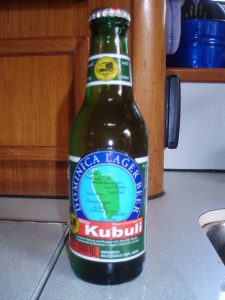
Speaking of food, Dominica brews a superb beer that complements any Creole or American meal. It is called Kubuli, after the name the local Carib Indians used for the island. It is another case of simple is better… in fine print the ingredients consist of just malted barley, hops and water. The only problem is that they come in a 250ml size – Heineken does the same thing down here – which is noticeably smaller then the standard 12 oz beer we are used to in the states!
Food aside, the real reason we had come to Roseau was to meet with a guy named Sea Cat. Several of our friends had used him as a guide and it seemed like a trip to Dominica would not be complete without engaging his services. It was not hard to find him. As we approached the anchorage, a fellow in a small wooden skiff motored out to us, encouraging us to follow him to a mooring. His name was Roots and he works the anchorage for Sea Cat. He secured us on a mooring right next to Villomee and ran a stern line to the dock ashore. The water here drops off rapidly from the beach, and much of the bottom consists of rocky boulders, so these ‘boat boys’ do a healthy busy with the moorings and stern line assistance. Their expected tip is reasonable and even though we could do these tasks ourselves, it is a way, as the cruising guide states, to ‘help a little to boost the local economy’.
We arranged with Sea Cat to take us, along with Hunter and Devi (Arctic Tern), on a tour inland. We were joined in the minibus by five other noisy but otherwise friendly sailors from Slovenia. If you are wondering how all of us would fit into a minibus, with room to spare, it is a well rehearsed process throughout these islands. The standard bus, shown below, is narrower and shorter than the typical minivan in the states, but amazingly, they can fit 15 people in these things! No space is wasted! There are five rows of knee-jamming seats, and with the use of a fold down seat next to each bench seat that fills in the narrow aisle, you can fit 3 adults across each row! And, the bus still manages to climb the steeply pitched volcanic mountains here. It is when they come careening down those roads, swerving this way and that way to avoid the pot holes while passing a hair’s width mirror to mirror with the upcoming traffic, that I become very nervous!
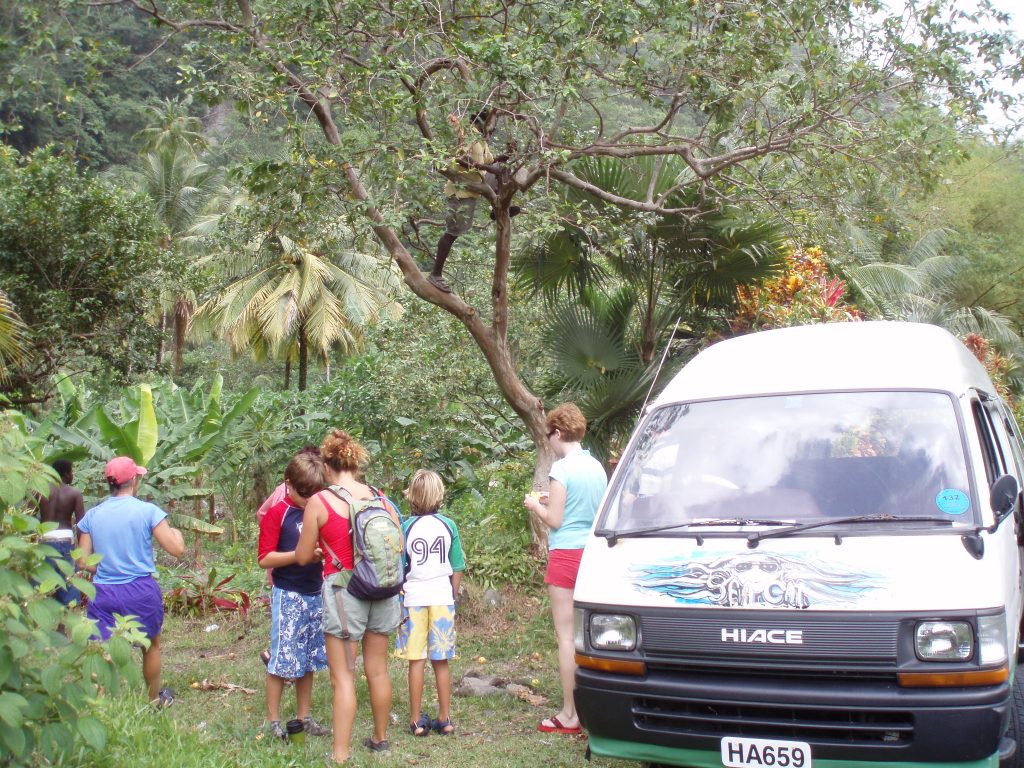
We started off the trip with a visit to the home of a friend of Sea Cat, one of many visits we would make during the day. Sea Cat was up in a tree before we could stumble out of the minibus, knocking down fresh guava fruit for us to enjoy.

Before I had a chance to peel back the skin of the guava, Sea Cat was busy preparing coconuts that his friend had just plucked from his coconut palm moments before. Coconuts can be picked here in at least two ways – green or mostly brown. The green coconuts, after the husk is cut away, contain a large amount of coconut water – with just a hint of sweetness – and less of the traditional white coconut ‘meat’. If you let the coconut hang longer, you get what most of us are familiar with after cutting away the outer husk – a brown shell with a thick layer of coconut meat inside. For this morning, we were treated to the green variety, with more than a large glassful-worth of coconut water inside. That’s enough to fill your bladder promptly and cause much agony an hour later while you bump along on the mountain roads in your ever-so-cramped minibus! But Sea Cat said, as he guzzled a whole coconut’s worth of the liquid, that you have to ‘take it like a man!’
Ever wonder how cocoa beans grow in this part of the world? Sea Cat plucked a ‘nut’ about the size of a small football from a roadside tree, and after cracking it open on a nearby boulder, delivered to us these slimy white beans.

The texture of these beans pegged the scale of inedible according to our youngest, but the adults enjoyed sucking on the outside – slimy yet satisfying as Timone said in Lion King. Once you suck the outside of the bean, you dry the rest of the bean in the sun and then roast it and after some grinding and sweetening, you have, in theory, chocolate. The flies invaded our sun dried beans after a week, so we’ll have to take the locals on their word!
The main destination of the tour was a one hour hike to Victoria Falls which required fording a river five times. Villomee had been on this same hike the day before when the river swelled under continual tropical showers and made climbing over the boulders very treacherous; today, we were blessed with sunny skies and good companionship. Our youngest received the most help – from both us and the Slovenians. Sometimes it pays to be the youngest kid around!
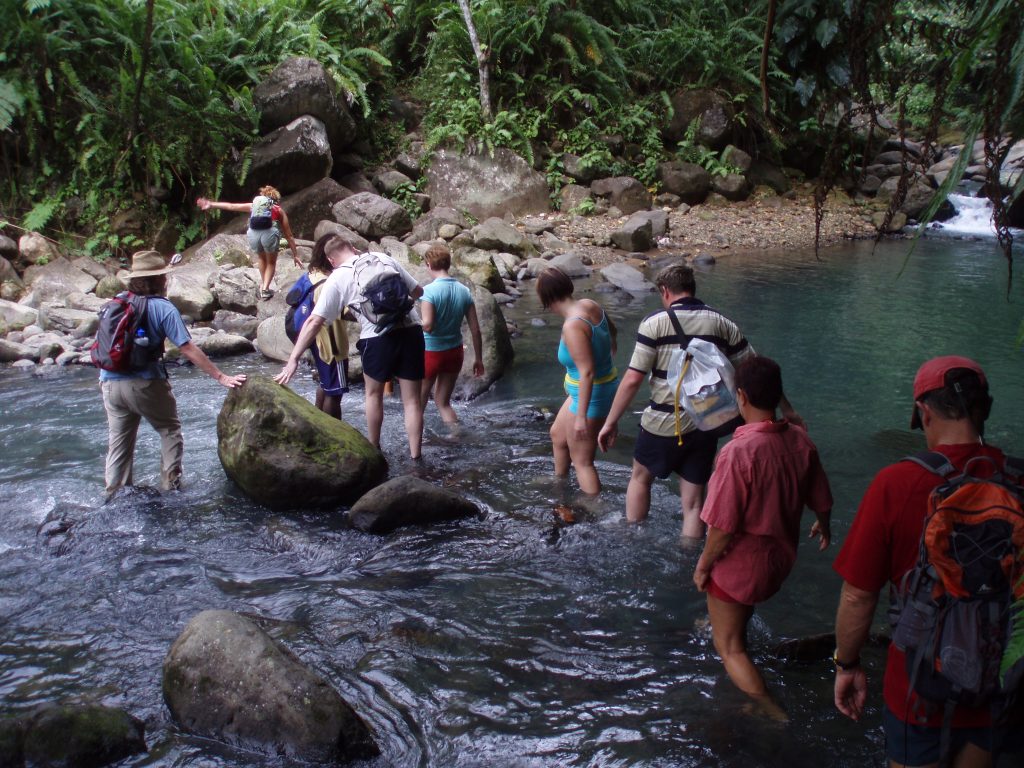
Victoria Falls was more immense – in size and grandeur – than any other falls we had seen in Dominica. The five crossings of the river and the scrambling over boulder after boulder were well worth it.

This next picture will give you a better idea of the size of the falls, as you look at how small we are in the water. The wind induced from the falling water would be strong enough to be a major concern on Thalia. It made it impossible to swim upwind and against the current to the teeming caldron when the falls landed in the pool, as stinging water drops made looking forward impossible!
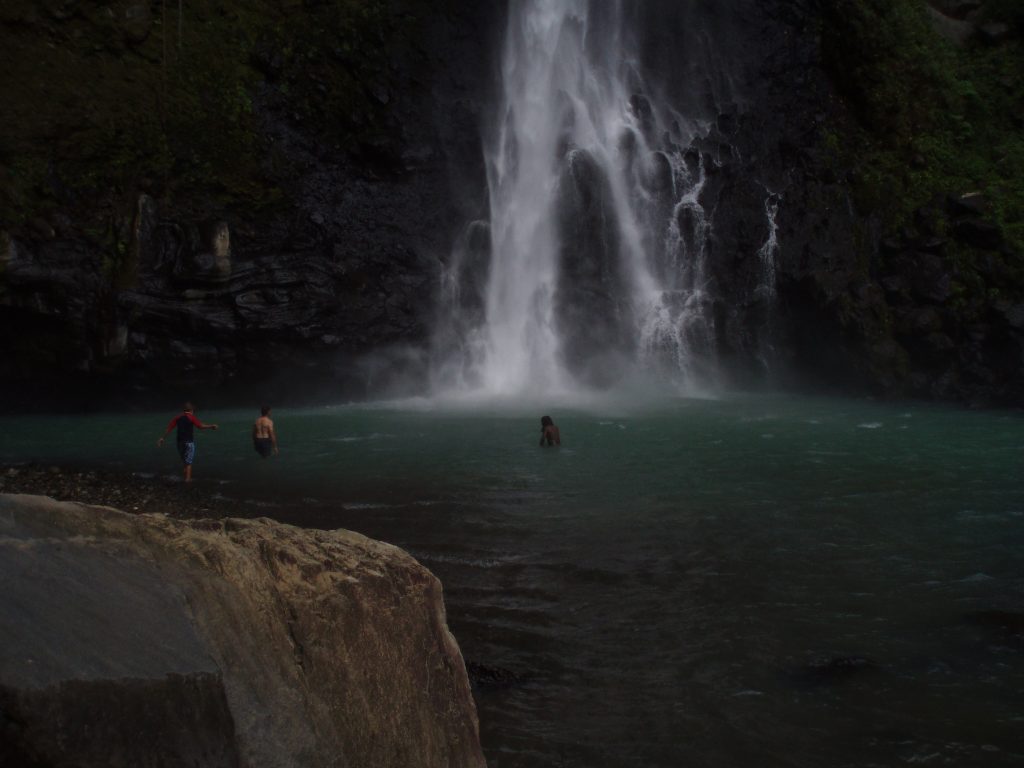
But, a vigorous, refreshing swim was not all that was in store for us. The benefit of a guide like Sea Cat — who jumped in the water quicker and with more vigor than any of us — is their local knowledge. In the above picture, just to the right of the falling water, were two small caverns, with room for only 2-3 people at a time. They were accessible only by swimming as far as you could along the rocks, then diving under the falling water and clinging to cracks in the rocks behind the falls. The roar of the water was deafening, making us shout much like we had to do during the Castine storm, but you could not beat the adrenaline rush! But this was not all. Sea Cat had more in store for us! He guided Zack and I up the rocky outcropping immediately to the right of the falling water for a dive off the rocks into the watering depths. Here’s yours truly in midair. Don’t you agree that my form is much better than Karen’s Capitol Island bridge jump last summer?!

After all of this activity, we were in desperate need of food, and Sea Cat had arranged for a guy named Moses to serve us some of his famous soup when we returned back down at the trailhead. Moses is another one of those characters on Dominica that you’ll hear frequently mentioned among Caribbean cruisers. His Rastafarian lifestyle was in full evidence, as he greeted us and gave us a walk through his extensive garden – the source for his amazing soups. Here he is greeting Hunter with the welcoming words “‘Bones of my bones, heart of my heart!”

His garden gave him everything he needed, including a papaya tree shown below.
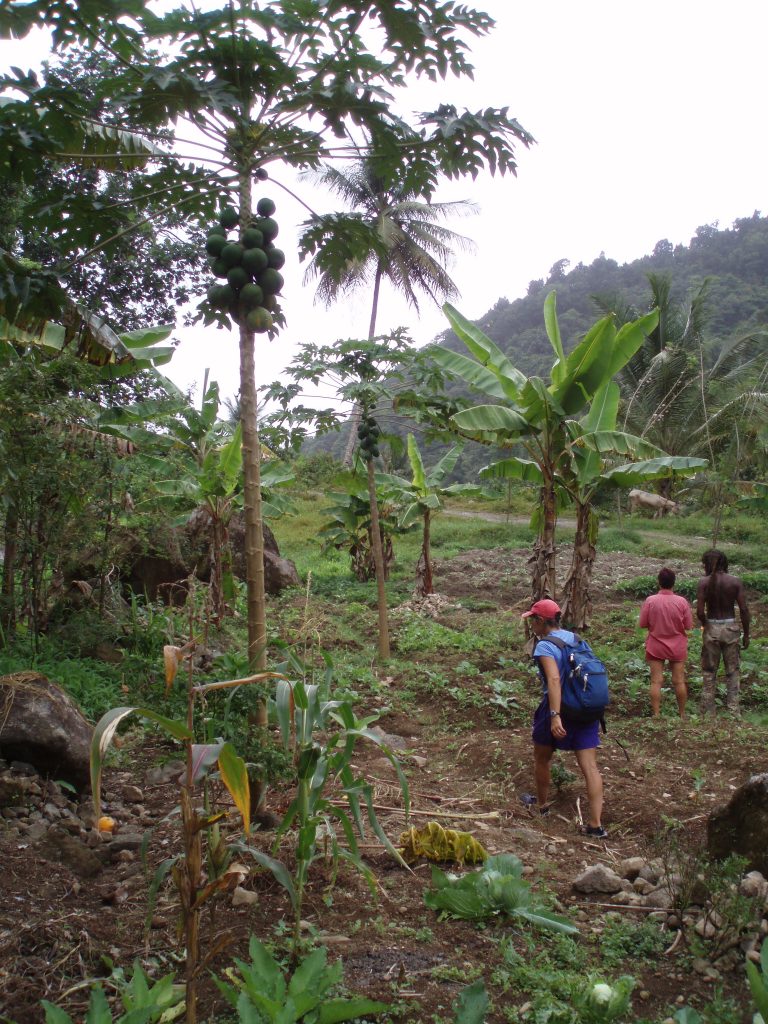
While we were on our hike, Moses was cooking up our soup, containing a coconut milk base with plantains, christophene (like a potato), mustard leaves and much more unusual stuff that didn’t stick in my brain!

If, as a marketeer, you believe the packaging is as important as the contents, then Moses succeeded here too. He served the soup in half round bowls made from the fruit of the Calabash tree – a gourd type fruit. And, the soup spoons were wedges cut from the shell of a coconut. Moses enjoyed the fact that all of us chose the coconut spoons over the traditional metal spoons that were made available.
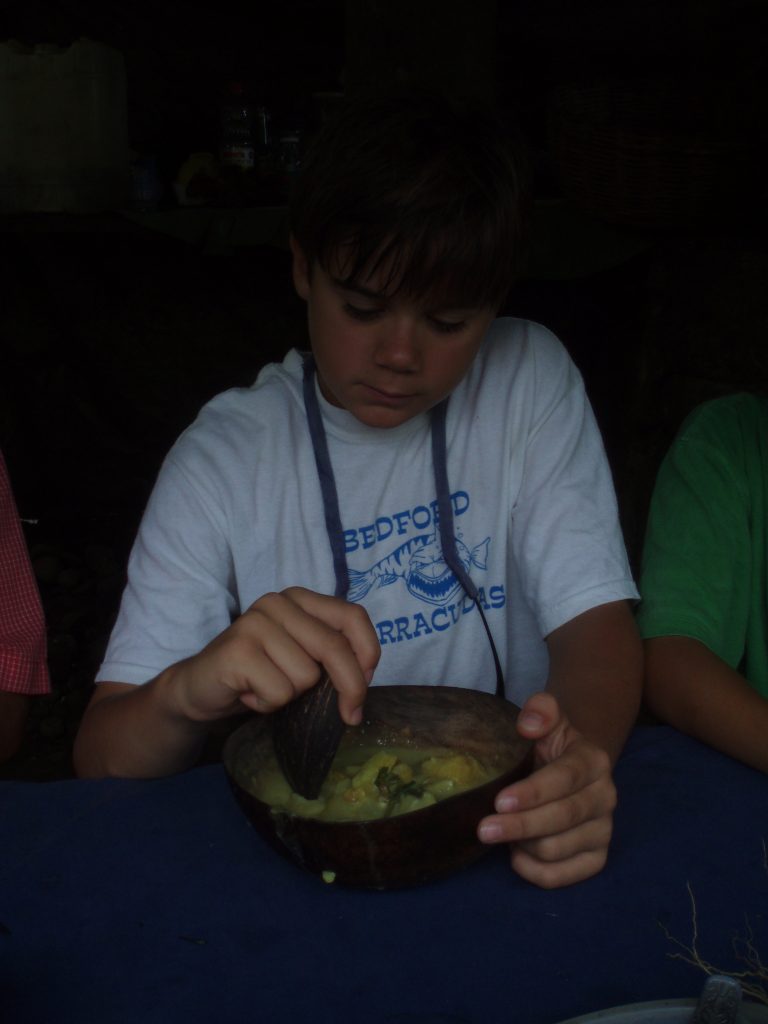
With our hunger satiated, Sea Cat drove us along the rough eastern coast line, where the beaches are worn away from the continual exposure to the westward flow of weather systems. Here, along the black sand beach, Sea Cat showed us how to survive if we were ever picked for the next Survivor TV series. This time, he picked a very brown coconut, and after launching it at a large boulder, cracked the outer shell and peeled away the husky fibrous layers, telling us that all the parts of the coconut had a use. For instance, the fibers can be used for bed mattresses or as a good scrub brush in the kitchen. With the inner brown coconut shell remaining, he took a small, flat beach stone, and with careful aim, cracked the top portion of the coconut shell free, exposing the thick, white coconut meat inside. Sections of the meat were broken away by hand and we all had sizable chunks of coconut to munch on for an afternoon treat… all produced with the use of human hands! And, speaking of Survivor, you should keep your eye on the TV in the next few months as we saw a film crew on the island and the rumor was that they were filming a new Survivor Dominica series!
Our travels with Sea Cat ended after one final stop, this time at a friend of his that runs a grapefruit orchard. The boys were up in the tree this time, helping Sea Cat pull down handful after handful of grapefruits.

We ended up all carrying shirt tail loads of grapefruit back to the minibus. In the process, we learned a bit more about the agricultural situation on the island. Sea Cat said that many growers were letting their fields and orchards go fallow, as they lost out in the export marketplace versus cheaper producing countries such as Honduras. This has hit the banana plantations especially hard. Due to the steep slopes on the island and therefore the greater expense for harvesting, Dominica has been unable to compete on price with other banana producing countries. Further, there has been pressure from the US, where United Fruit – a large banana conglomerate with production in South and Central America – is based, to level the international marketplace by reducing trade sanctions and subsidies. These restrictions had helped Dominica and other nearby islands compete, but now their export markets are falling away. Hopefully, they will still keep growing fruit, though, so that visitors like us can savor the amazing flavors of this island in paradise!We will leave our friends on Arctic Tern, Asseance and Villomee tomorrow, as we head south. We are doing an aggressive push to get to the island of Bequia, a highly recommended spot for boaters. As we pass south of Dominica, we will cross the imaginary dividing line from the Leeward Islands to the Windward Islands, so named because they are occasionally involve a beat upwind. We will welcome the challenge, as we seek new discoveries and experiences!
